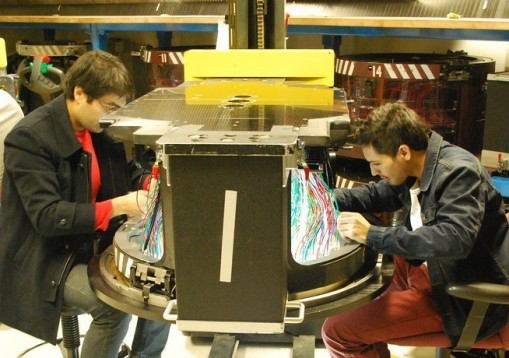A post by Garrett Ebelke, Telescope Operation Specialist and APOGEE Hardware Development and Training Coordinator at Apache Point Observatory. Translated into Spanish by Loreto Barcos and Guillermo Damke (University of Virginia), with help from Veronica Motta (Universidad de Valparaíso, Chile).
Publicado por Garret Ebelke, Especialista de Operaciones del Telescopio y Coordinador de Desarrollo y Entrenamiento del Instrumento de APOGEE del Observatorio Apache Point. Traducido al Español por Loreto Barcos-Muñoz y Guillermo Damke (Universidad de Virginia, con ayuda de Veronica Motta (Universidad de Valparaíso, Chile).
Durante la segunda mitad de Abril, los ingenieros Daniel Garrido y Mario Cáceres viajaron desde Chile al Observatorio Apache Point (APO, por sus siglas en inglés), en Nuevo México, como parte del proyecto QUIMAL de la Universidad de La Serena. El objetivo de su viaje fue conocer en profundidad la infraestructura del instrumento de APOGEE para adquirir un conocimiento más acabado de sus numerosos subsistemas. Estos serán replicados en el proyecto APOGEE-2 e instalados en el telescopio du Pont de 2.5 m ubicado en el Observatorio Las Campanas (LCO, por sus siglas en inglés).
During the second half of April, Daniel Garrido and Mario Caceres, both engineers from Chile, travelled to Apache Point Observatory in New Mexico as part of the QUIMAL project at the Universidad de La Serena. The purpose of their trip was to delve deep into the APOGEE infrastructure hardware to gain a better understanding of the numerous hardware sub-systems. These systems will be replicated for the APOGEE-2 project and installed at the du Pont 100-inch Telescope at Las Campanas Observatory.
[For more on the plans for APOGEE observing at Las Campanas see this blog post.]

Daniel Garrido (left), Mario Caceres (right) at APO. Daniel Garrido (a la izquierda) y Mario Cáceres (a la derecha) en APO.
While at APO, they were introduced to the daily task of plugging fiber optics into spectrographic plug plates, all contained within cartridges. They became very familiar with mounting these cartridges to the telescope, and how much care must be taken when handling the cartridges. A similar cartridge design will be used at LCO and Daniel will be heavily involved in assembling and populating the cartridges with fiber optics. Daniel was very eager to explore the internal configuration of the cartridges and quickly got his hands dirty once we opened a cartridge.
Durante su visita a APO, se les inició en la tarea diaria de conectar fibras ópticas a placas espectrográficas, cada una contenida en distintos cartuchos. Daniel y Mario también aprendieron a montar estos cartuchos en el telescopio y entendieron la delicadeza de este proceso. Los cartuchos que se utilizarán en el LCO tendrán un diseño similar. Daniel además estará involucrado en el montaje e instalación de las fibras ópticas en los cartuchos en el LCO. Daniel mostró mucho entusiasmo en explorar la configuración interna de los cartuchos y no tuvo inconvenientes en “ensuciarse las manos” para estudiarlos por sí mismo.

Mario y Daniel conectando las fibras ópticas en una placa espectrográfica. Mario and Daniel plugging fiber optics into a spectrograph plug plate.

Daniel pushes a cartridge to the telescope. Daniel empuja un cartucho hacia el telescopio.

Daniel (a la izquierda) y Mario (a la derecha) exploran la configuración interna de un cartucho de APOGEE. Daniel (left), Mario (right) explore the internal configuration of an APOGEE fiber optic cartridge.
No pudimos dejarlos marcharse de APO sin antes llevarlos a disfrutar del lado oscuro de las operaciones, donde pasaron varias noches familiarizándose con las operaciones nocturnas. Una parte importante de las observaciones es el aprendizaje del software usado para controlar el telescopio y el instrumento de APOGEE.
We couldn’t let them leave APO without letting them join the dark side of operations, where they spent several nights being introduced to nightly operations. A major part of observing is learning the software used to interface with the telescope and the APOGEE instrument.

Moses Marchante (SDSS Telescope Operations Specialist) introduces Daniel and Mario to the interface software used to control the telescope and the APOGEE instrument. Moses Marchante, Especialista de Operaciones del Telescopio Sloan Digital Sky Survey (Relevamiento Digital del Cielo Sloan, SDSS por sus siglas en inglés), les enseña a Daniel y Mario el software de la interface usada para controlar el telescopio y el instrumento APOGEE.
This was an excellent start to incorporating some Chilean participants to the APOGEE-2 project, the hardware designs, operational processes and forge an excellent working relationship that will last throughout the entire project.
Esta fue una gran oportunidad para comenzar a incorporar participantes chilenos al proyecto APOGEE-2, al diseño del instrumento, los procesos operacionales, y para forjar una excelente relación de trabajo que durará a lo largo de todo el proyecto.

Daniel y Mario frente al instrumento APOGEE. Daniel and Mario in front of the APOGEE instrument.
All photos were taken using Daniel Garrido’s camera.












